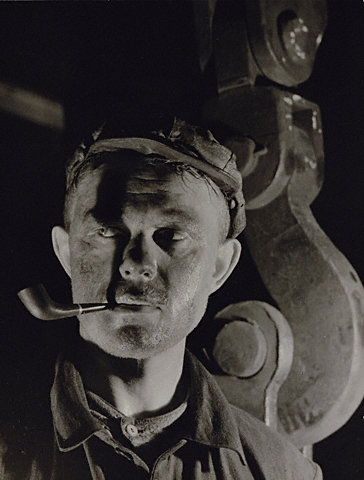In Focus: The Worker
dal 2/11/2009 al 20/3/2010
Segnalato da
2/11/2009
In Focus: The Worker
J. Paul Getty Museum, Los Angeles
More than 40 photographs of the 19th and 20th centuries

The invention of photography was announced in 1839, when the Industrial Revolution was transforming daily life in the Western world. Workers of all types were central to these changes, and the camera was used—more than any other artistic medium—to picture them. In Focus: The Worker presents a photographic history of working people across many cultures.
The more than 40 prints in this exhibition are drawn exclusively from the J. Paul Getty Museum's collection. They include a range of photographic processes from daguerreotypes to gelatin silver prints. Some represent key moments in history and have become icons. Others are less well-known, but demonstrate the diversity of occupations and trades that interested photographers. Taken together, they reveal shifting attitudes toward the worker over much of the 19th and 20th centuries.
Vocational Photography: Workers and Their Tools
In its day, a daguerreotype portrait was considered a luxury product, especially those that were hand-colored.
In this early image of a worker, the photographer treats his subject with studied consideration. The carpenter regards the camera with a grave expression, and we sense that it might be the first time he has ever been photographed. His tools, including a bench plane and miter saw, sit before him like elements arranged in a formal still life.
This portrait looks staged for a variety of reasons. The pile of wood shavings at the bottom right corner is too tidy to reflect actual work in progress. The austere background and composition also point to a formal photography session in a studio rather than in the carpenter's workroom.
Picturing Workers at Work
This photograph offers a view of both the people and materials behind the construction of the Eiffel Tower. The artist, Louis-Émile Durandelle, shows the workers dwarfed by the array of piers and caissons that will become part of the tower's foundation. The site dominates the frame, with only a small element reserved for the sky at the top.
Durandelle is known for his architectural photographs, especially of public monuments. The tower's architect and namesake, George Eiffel, likely commissioned him to record various stages of construction as a documentary record. This photograph came from Eiffel's own personal archives.
Photographs as Tools for Social Change
Photographer Lewis Hine made this image when on assignment for the National Child Labor Committee. By framing the scene tightly and selecting a low camera height, Hine establishes an eye-to-eye relationship between the young girl and the viewer. His work documenting the negative effects of child labor was among the earliest and most effective uses of photography as a catalyst for social change.
The enormous sewing machine behind this young worker stretches out behind her as if to infinity. Unsmiling, she rests one hand on the window sill and the other on the machine. Her apparent ease in the bleak environment is disconcerting, as if she knows it better than whatever landscape or playground might be on the other side of the window.
Contemporary Directions
Milton Rogovin traveled to coal-mining areas throughout the world and created a series of environmental portraits of miners at work and at home with their families. His purpose was not to represent the wearing-down effects of hard labor per se, but to call attention to individuals whose jobs are characterized by constant danger and low pay.
This photograph is one part of a diptych made near Guantánamo, Cuba. Rogovin builds the picture around the central figure, a man who appears to be a leader among the group of men that surrounds him. Presenting him head-on and informally posed, the artist shows us that this man is both courageous and proud.
Image: Man with Pipe, Paul Wolff, German, about 1940. Gelatin silver print 9 1/8 x 6 15/16 in. (23.2 x 17.6 cm) 84.XM.139.126
Media Contact:
Melissa Abraham 310-440-6861; mabraham@getty.edu
J. Paul Getty Museum
1200 Getty Center Drive Los Angeles, CA 90049-1687
Opening Hours
The Getty Center is open Tuesday through Friday and Sunday from 10 a.m. to 5:30 p.m., and Saturday from 10 a.m. to 9 p.m.
It is closed Monday and and on January 1, and December 25.
Admission to the Getty Center is always free.



